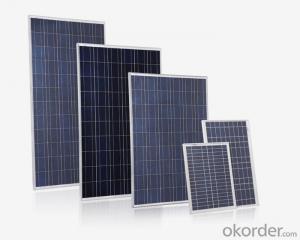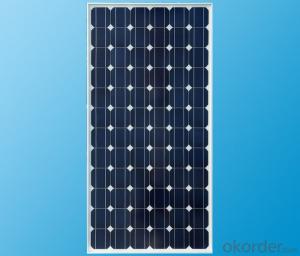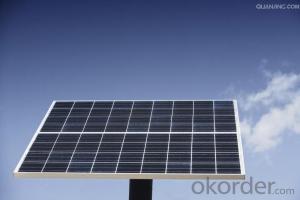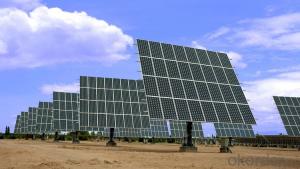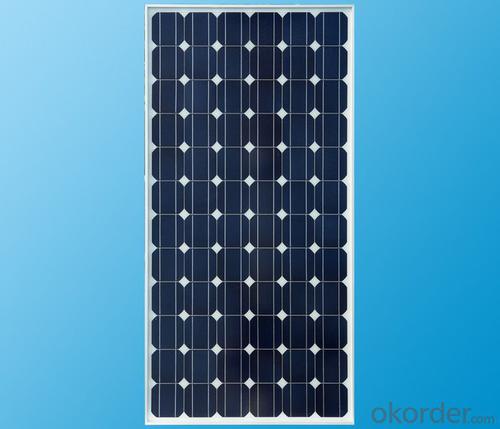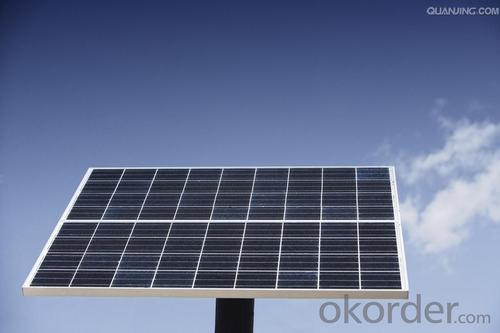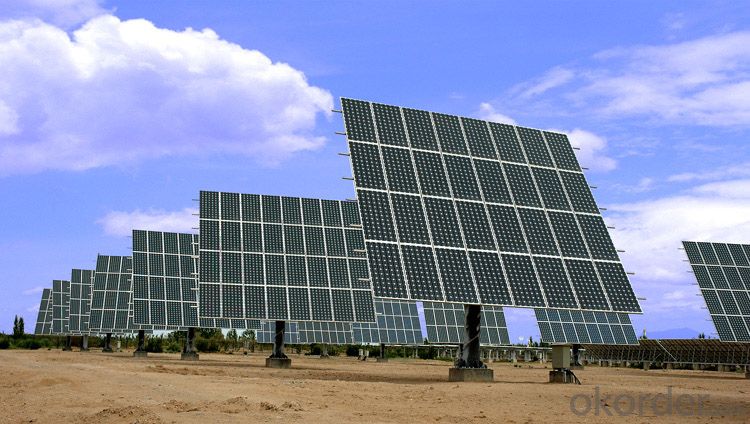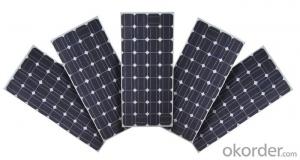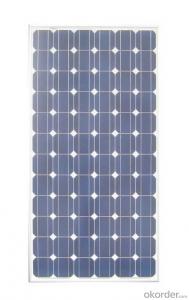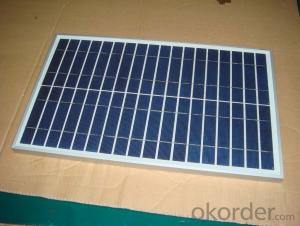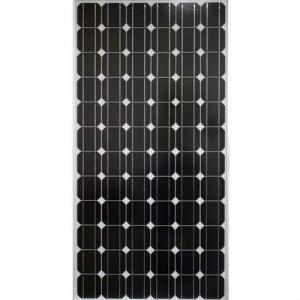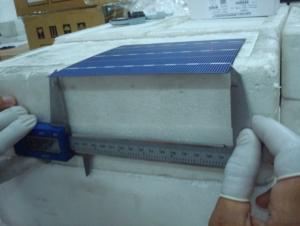Qd Solar Cells Favorites Compare Poly Solar Panel 280W-300W with 156*156 Solar Cell for Solar Power System
- Loading Port:
- China Main Port
- Payment Terms:
- TT OR LC
- Min Order Qty:
- -
- Supply Capability:
- 10000000000000 watt/month
OKorder Service Pledge
OKorder Financial Service
You Might Also Like
Quick Details
| Place of Origin: | Guangdong China (Mainland) | Brand Name: | CAP | Model Number: | 50w100w150w200w250w300w |
| Material: | Monocrystalline Silicon | Size: | 1385*1035*75mm | Number of Cells: | 72pcs |
| Max. Power: | 300w | type: | solar panel | color: | blue&black |
| warranty: | 5 years |
Packaging & Delivery
| Packaging Detail: | standard export package for solar panel |
| Delivery Detail: | 7-15 days for solar panel |
Specifications
solar panel
High Efficiency
25 years Warranty
High-transmissivity low-iron tempered glass
Solar Panel
50w100w150w200w250w300w
Characteristics
1,High and stable conversion efficienly based on over 4 years professional experience
2 ,High reliability with guaranteed +/-10% output power tolerance
3,Proven materials,tempered front glass,and a sturdy anodized aluminum frame allow modules to operate reliably in multiple mountily configurations
4,Combination of high efficicncy and attractive appearance
Quality and Safety
1,25 year 80%,10 year 90% power warranty 3 year power warranty
2,ISO9001:2000 (Quality Management system) certified factory
3,Product Quality warranty & products Liability Insurance to guarantee and user' benefits
4,Certifications TUV Intercert, CE Temperature Coefficients
| Module Type | 100w | 150w | 200w | 250w | 300w |
| Maximum Power at ST(Pmax)W | 100wp | 150wp | 200wp | 250wp | 300wp |
| Maximum Power Voltage(Vmp)V | 36/18 | 36/18 | 36/18 | 30.8v | 36/18 |
| Maximum Power Current(Imp)A | 2.77/5.55 | 4.16/8.33 | 5.55/11.1 | 8.11A | 8.33/16.66 |
| Open Circuit Voltage(Voc)V | 39.5/19.05 | 39.3/19.4 | 39.6/19.5 | 36.2V | 39.6/19.8 |
| Short Circuit Current(Isc)A | 3.04/6.09 | 4.58/9.16 | 6.1/12.2 | 8.7A | 9.16/18.33 |
| Cell Efficiency(%) | 18.60% | 18.10% | 18.60% | 17.80% | 18.10% |
| Module Efficiency(%) | 17.70% | 17.20% | 17.70% | 17.10% | 17.20% |
| Operating Temperature°C | -40°C to +85°C | -40°C to +85°C | -40°C to +85°C | -40°C to +85°C | -40°C to +85°C |
| Maximum system voltage | 1000V(IEC)DC | 1000V(IEC)DC | 1000V(IEC)DC | 1000V(IEC)DC | 1000V(IEC)DC |
| Power tolerance | -0.03 | -0.03 | -0.03 | -0.03 | -0.03 |
| Temperature coefficients of Pmax | -0.45%/°C | -0.45%/°C | -0.45%/°C | -0.45%/°C | -0.45%/°C |
| Temperature coefficients of Voc | -0.27%/°C | -0.27%/°C | -0.27%/°C | -0.27%/°C | -0.27%/°C |
| Temperature coefficients of Isc | 0.05%/°C | 0.05%/°C | 0.05%/°C | 0.05%/°C | 0.05%/°C |
| Weight(kg) | 8 | 11 | 14 | 20 | 25.5 |
| Number of cell(pcs) | 4*9 | 4*9 | 6*10 | 6*12 | 6*12 |
| Dimensions(mm) | 1194*534*35/30 | 1580*808*50/35 | 1471*670*40/35 | 1640*992*50 | 2000*1050*50 |
- Q: What is the maximum temperature a solar cell can withstand?
- The maximum temperature a solar cell can typically withstand is around 85 to 90 degrees Celsius (185 to 194 degrees Fahrenheit). However, this can vary depending on the specific materials and design of the solar cell.
- Q: I studied very hard at school, but I just can not figure out how solar cells work, anybody can help me with that?
- The process of solar cells' conversion first requires a material which absorbs the solar energy (photon), and then raises an electron to a higher energy state, and then the flow of this high-energy electron to an external circuit. Silicon is one such material that uses such process.
- Q: Can solar cells be used for large-scale power generation?
- Yes, solar cells can be used for large-scale power generation. Advances in technology and economies of scale have made solar power increasingly cost-effective and efficient. Large solar arrays, known as solar farms, are capable of generating significant amounts of electricity to meet the energy demands of cities and even entire regions. Additionally, solar power is a clean and renewable energy source, making it an attractive option for reducing greenhouse gas emissions and mitigating climate change.
- Q: Can solar cells be used in charging electric bikes?
- Yes, solar cells can be used to charge electric bikes. Solar panels are capable of converting sunlight into electricity, which can then be used to charge the batteries of electric bikes. This allows for a sustainable and environmentally friendly way of powering electric bikes.
- Q: How to manufacture solar cells?
- It's a bit difficult to describe.
- Q: Can solar cells be used in street lighting?
- Yes, solar cells can be used in street lighting. Solar street lights combine solar panels, batteries, and LED lights to generate and store energy during the day, which is then used to power the lights at night. This renewable energy source makes solar cells an efficient and sustainable option for street lighting, reducing carbon emissions and reliance on the electrical grid.
- Q: How do solar cells perform in areas with high levels of snowfall?
- Solar cells generally do not perform optimally in areas with high levels of snowfall. The accumulation of snow on the surface of solar panels can significantly reduce their efficiency by blocking sunlight and preventing the cells from generating electricity. Regular snow removal or tilting the panels at an angle can help mitigate this issue, but it may still impact their overall performance in such regions.
- Q: Can solar cells be used in large-scale power plants?
- Yes, solar cells can be used in large-scale power plants. In fact, large-scale solar power plants, also known as solar farms or solar parks, are becoming increasingly common as the technology improves and costs decrease. These power plants consist of a large number of solar panels or solar arrays that convert sunlight into electricity on a massive scale.
- Q: How do solar cells compare to fossil fuels in terms of energy production?
- Solar cells have several advantages over fossil fuels in terms of energy production. Firstly, solar cells harness renewable energy from the sun, while fossil fuels are non-renewable and finite resources. Secondly, solar cells produce clean energy, emitting no greenhouse gases or pollutants, whereas fossil fuels release harmful emissions that contribute to climate change and air pollution. Additionally, solar cells can be installed on rooftops or in remote areas, making energy production more decentralized and less reliant on centralized power plants. However, solar cells currently have limitations in terms of efficiency and storage capacity, which fossil fuels have a higher energy density and can provide continuous power supply. Overall, solar cells offer a sustainable and environmentally-friendly alternative to fossil fuels, but further advancements are needed to fully replace their energy production capabilities.
- Q: What is the expected degradation rate of a solar cell?
- The expected degradation rate of a solar cell can vary depending on various factors such as the type of solar cell, the quality of materials used, the environmental conditions, and the maintenance practices. On average, however, most solar cells experience a degradation rate of around 0.5% to 1% per year. This means that the efficiency of the solar cell decreases by this percentage over time. Proper maintenance and regular cleaning can help mitigate degradation and extend the lifespan of a solar cell.
Send your message to us
Qd Solar Cells Favorites Compare Poly Solar Panel 280W-300W with 156*156 Solar Cell for Solar Power System
- Loading Port:
- China Main Port
- Payment Terms:
- TT OR LC
- Min Order Qty:
- -
- Supply Capability:
- 10000000000000 watt/month
OKorder Service Pledge
OKorder Financial Service
Similar products
Hot products
Hot Searches
Related keywords
